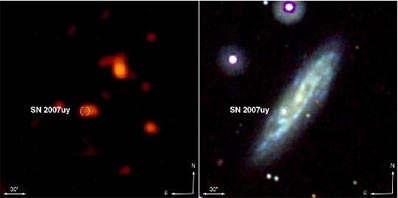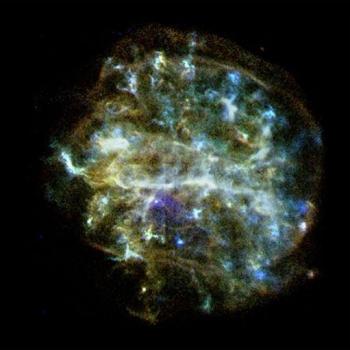You are hereBlogs / WcP.Scientific.Mind's blog / Scientists Observe Birth of a Supernova, Captured on Camera For the First Time
Scientists Observe Birth of a Supernova, Captured on Camera For the First Time
Original Source: Spaceflight Now
(quote)
PRINCETON, NJ -- When she peered into the screen of her computer one day in January, Alicia Soderberg was supposed to see a small, dull glowing smudge in one corner, the evidence of a month-old supernova that would help her better understand the mystery of these huge exploding stars. What the Princeton University astronomer saw instead was anything but dull. As Soderberg and Edo Berger, a postdoctoral research associate at Princeton, studied the X-ray emissions conveyed from space by NASA's Swift satellite, they saw an extremely bright light that seemed to jump out of the sky. They didn't know it, but they had just become the first astronomers to have caught a star in the act of exploding. The once-in-a-lifetime event, described in a paper published in the May 22 issue of Nature, has transfixed the worldwide astronomical community.
Soderberg and Berger wanted to observe a supernova known as SN 2007uy in the spiral galaxy NGC 2770, located 90 million light years from Earth in the constellation Lynx. They could plan to do that because they are able to view images captured by the telescope a few hours after the observation merely by downloading the data from the Swift website. The sudden appearance nearby of the X-ray burst of the newer supernova, easily captured by the NASA satellite with multiple instruments that can detect gamma rays, X-rays and ultraviolet light, has set scientists on a new path. "This phenomenon had been predicted more than 30 years ago, but is now observed for the first time," said Roger Chevalier, the W.H. Vanderbilt Professor of Astronomy at the University of Virginia. "These are the earliest observations of light from a supernova after the central collapse that initiated the explosion."
In the Nature paper, Soderberg and 38 colleagues show that the energy and pattern of the X-ray outburst is consistent with what scientists would have expected to see in the birth of a neutron star -- a shock wave blasting through the surface of the original massive star. Until now, astronomers have only been able to observe supernovae brightening days or weeks after the event, when the expanding shell of debris is energized by the decay of radioactive elements forged in the explosion.
(unquote)
Photos Courtesy of AFP and NASA/Swift Science Team/Stefan Immler





















